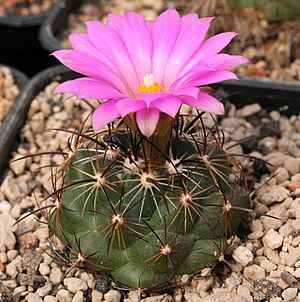Bunched cory cactus facts for kids
Coryphantha ramillosa is a very special and rare type of cactus. People often call it the bunched cory cactus or whiskerbush. This unique plant grows naturally in the border area between Texas in the United States and Coahuila in Mexico. Because it was thought to be quite rare and in danger, the United States government officially listed it as a threatened species in 1979. This means it gets special protection to help it survive.
Quick facts for kids Bunched cory cactus |
|
|---|---|
 |
|
| Conservation status | |
| Scientific classification | |
| Kingdom: | |
| (unranked): | |
| (unranked): | |
| (unranked): | |
| Order: | |
| Family: | |
| Subfamily: | |
| Tribe: |
Cacteae
|
| Genus: | |
| Species: |
C. ramillosa
|
| Binomial name | |
| Coryphantha ramillosa Cutak
|
|
Contents
Where Does This Cactus Live?
This cactus is found in both Texas and Mexico. It grows in at least seven different spots in Texas. Several of these places are inside Big Bend National Park, which helps protect them.
How Many Are There?
Scientists once thought this cactus was extremely rare. However, more recent studies suggest there might be more of them than first believed. In Texas, there could be between 5,000 and 10,000 plants in just two counties.
The area where this cactus can grow in Mexico is much larger than in Texas. Many of these plants live in remote, hard-to-reach places. This helps keep them safe from people who might try to collect them.
Why Is It Threatened?
One of the biggest dangers to the Coryphantha ramillosa is people collecting them. Some cactus fans or dealers try to take these plants from their natural homes. This can harm the wild populations.
What Does It Look Like?
The Coryphantha ramillosa cactus is usually shaped like a ball or a cylinder. It does not have branches. It can grow up to about 9.5 centimeters (about 3.7 inches) tall.
Spines and Texture
Its surface has bumps called areoles, which can be up to 2 centimeters (about 0.8 inches) tall. These areoles have curved spines. The main spine is thick and dark, growing up to 4.3 centimeters (about 1.7 inches) long. The smaller spines are lighter, often white.
Flowers and Fruit
A beautiful flower grows at the very top of the cactus. It can be up to 6.5 centimeters (about 2.5 inches) long. The petals, called tepals, are pink. They get lighter, almost white, near the center. Sometimes, they have darker stripes down the middle.
After the flower, a round fruit grows. It is pale to dark green, juicy, and about 1 to 2 centimeters (0.4 to 0.8 inches) long. This cactus usually blooms in the summer. If there is more rain, it can bloom for a longer time.
Where Does It Grow?
This cactus lives in desert scrub areas. These are dry, rocky places that are often hard to reach. Not many other plants can grow in these tough conditions. The soil where it grows is made of limestone.
Protecting the Cactus
The Coryphantha ramillosa is being grown and studied at the Desert Botanical Garden in Phoenix, Arizona. This helps scientists learn more about the plant and how to protect it. Growing them in a garden also helps reduce the need to take them from the wild.
See also
 In Spanish: Coryphantha ramillosa para niños
In Spanish: Coryphantha ramillosa para niños


